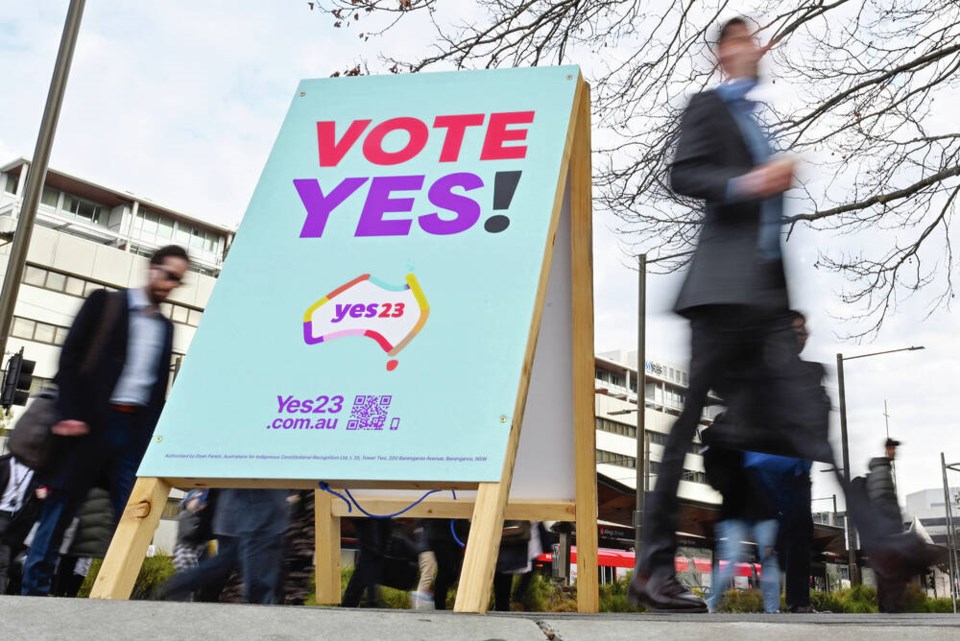Australians will go to the polls on Oct. 14 to vote in a referendum on the inclusion of a formal Aboriginal and Torres Strait Islander voice in the nation’s Commonwealth Constitution.
About 17 million registered voters across the country will vote on whether to change the constitution to recognize the land’s original inhabitants by creating a First Nations advisory group with a direct line to government.
The vote is being seen as a pivotal moment, not only because constitutional change is rare and almost irreversible but also because it illuminates racial issues that have festered in Australia for centuries.
Government statistics updated each year show colonization continues to take a toll on Australia’s Indigenous population, whose hundreds of distinct groups make up less than 4% of the population — some 800,000 people in a nation of 26 million.
In Canada, 1.8 million people identified themselves as Indigenous in the 2021 census, accounting for 5% of the country’s total population
The Oct. 14 referendum is a major step in the benighted history of Australia’s long and troubled relationship with its Indigenous people.
Depending on who wrote that history, the first documented European/Indigenous contact may have occurred when, in 1606, Dutch explorer Willem Janszoon landed on the western side of Cape York Peninsula.
My British Commonwealth-inspired school book said the first contact may have been on April 29, 1770, when Capt. James Cook’s Endeavour landed at Botany Bay near what is now Sydney. Archaeological evidence from the shores of Botany Bay has yielded evidence of an Aboriginal settlement dating back 5,000 years.
The Oct. 14 referendum will ask the Australian people whether they approve of adding the following words to the Commonwealth Constitution, Australia’s ultimate law: “In recognition of Aboriginal and Torres Strait Islander peoples as the First Peoples of Australia there shall be a body, to be called the Aboriginal and Torres Strait Islander Voice. The Aboriginal and Torres Strait Islander Voice may make representations to the Parliament and the Executive Government of the Commonwealth on matters relating to Aboriginal and Torres Strait Islander peoples.”
In Australia, voting in a referendum, as in an election, is compulsory. A single box is to be provided on the ballot paper, making it a “yes” or “no” vote.
At the other end of this potential paradigm shift in cultural thinking are Australia’s schools. After all, it’s during the school years that most changes in attitude develop.
A report by the Australian Council for Educational Research — “Indigenous Languages Programmes in Australian Schools: A Way Forward” — reviewed literature that found that of 250 known Australian Indigenous languages, fewer than 20 could be considered strong.
The report says: “Australian Aboriginal and Torres Strait Islander languages are the first languages of this continent. This status, and their unique value in the world’s languages, makes it imperative for them to be learned, taught, used, and protected from their current state of endangerment. School programmes have much to contribute to the health and vitality of Indigenous languages.”
The report also found that over 16,000 Indigenous students and 13,000 non-Indigenous students located in 260 Australian schools are involved in an Indigenous language program of some kind.
In those program, more than 80 Indigenous languages are taught. About 28% of the programs are first-language maintenance programs, and include bilingual programs undertaken by students in the early years of schooling and throughout their schooling.
About 12% of programs are second-language learning programs, where a language is taught to learners in the languages area of the school curriculum. In this type of program, students have little or no assumed knowledge of the target language.
About 50% of programs are language revival programs, including language revitalization (about 28%), where the language is still spoken by a small group of older speakers within the community.
There are also discussions regarding the development of a national curriculum that some hope will provide a timely forum for considering the place of Indigenous languages in school curricula.
Whatever happens, there can be little doubt that the result of the Oct. 14 referendum will either move Australia to the global forefront of realistic attempts at truth and reconciliation with an Indigenous population or, once again, provide evidence that not much has changed since Cook landed at Botany Bay in 1770.
Geoff Johnson is a former superintendent of schools.
>>> To comment on this article, write a letter to the editor: [email protected]



